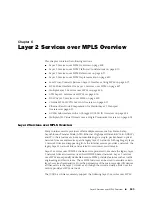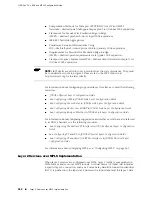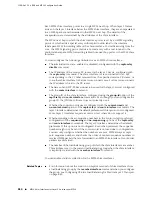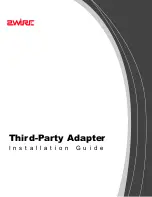
We recommend that for voice-over-ATM configurations, you select timeout values
between 6 microseconds and 3 x 6 microseconds. Values within this range are
generally low enough to maintain a reasonable cell delay and high enough to take
advantage of the cell concatenation mechanism.
If traffic shaping is enabled on the egress router, the JUNOSe implementation of VCC
cell relay encapsulation preserves the spacing between cells.
Control Word Support
VCC cell relay encapsulation requires use of a control word. The control word contains
the T, E, C, and U bits, as well as an optional sequence number field.
The JUNOSe implementation of VCC cell relay encapsulation supports the T bit, which
is always set to indicate raw ATM cells, and the optional sequence number. The E,
C, and U bits have no meaning for VCC cell relay configurations because the router
forwards a complete ATM cell with as much header information as possible.
Unsupported Features
VCC cell relay encapsulation on JUNOSe routers does not support the following
features:
■
Mapping multiple ATM VCs to a single MPLS pseudowire
■
Optional Martini one-to-one cell encapsulation method with cell headers removed
Related Topics
■
For information about AAL5 SDU encapsulation, see Encapsulation Methods for
Transport of ATM Over MPLS Networks—draft-ietf-pwe3-atm-encap-07.txt (April
2005 expiration)
■
For configuration examples of AAL5 SDU encapsulation using the
aal5all
encapsulation keyword when you configure ATM subinterfaces, see Configuring
Local ATM Cross-Connects with AAL5 Encapsulation on page 534
■
For information about, VCC cell relay encapsulation, see Encapsulation Methods
for Transport of ATM Over MPLS Networks—draft-ietf-pwe3-atm-encap-07.txt
(April 2005 expiration)
■
For VCC cell relay encapsulation configuration instructions, see Configuring an
MPLS Pseudowire with VCC Cell Relay Encapsulation on page 536
■
Control Word Support on page 517
HDLC Layer 2 Services over MPLS
E Series routers support the creation of HDLC layer 2 circuits across an MPLS network.
An HDLC layer 2 circuit can carry any standard HDLC traffic (including PPP) or
Cisco HDLC traffic between two CE devices across an MPLS network. In an HDLC
layer 2 circuit configuration, an E Series router functions as one of the PE routers.
HDLC Layer 2 Services over MPLS
■
519
Chapter 6: Layer 2 Services over MPLS Overview
Summary of Contents for BGP
Page 6: ...vi ...
Page 8: ...viii JUNOSe 11 1 x BGP and MPLS Configuration Guide ...
Page 37: ...Part 1 Border Gateway Protocol Configuring BGP Routing on page 3 Border Gateway Protocol 1 ...
Page 38: ...2 Border Gateway Protocol JUNOSe 11 1 x BGP and MPLS Configuration Guide ...
Page 234: ...198 Monitoring BGP JUNOSe 11 1 x BGP and MPLS Configuration Guide ...
Page 236: ...200 Multiprotocol Layer Switching JUNOSe 11 1 x BGP and MPLS Configuration Guide ...
Page 542: ...506 Monitoring BGP MPLS VPNs JUNOSe 11 1 x BGP and MPLS Configuration Guide ...
Page 544: ...508 Layer 2 Services Over MPLS JUNOSe 11 1 x BGP and MPLS Configuration Guide ...
Page 610: ...574 Virtual Private LAN Service JUNOSe 11 1 x BGP and MPLS Configuration Guide ...
Page 624: ...588 VPLS References JUNOSe 11 1 x BGP and MPLS Configuration Guide ...
Page 680: ...644 Virtual Private Wire Service JUNOSe 11 1 x BGP and MPLS Configuration Guide ...
Page 724: ...688 Monitoring MPLS Forwarding Table for VPWS JUNOSe 11 1 x BGP and MPLS Configuration Guide ...
Page 725: ...Part 6 Index Index on page 691 Index 689 ...
Page 726: ...690 Index JUNOSe 11 1 x BGP and MPLS Configuration Guide ...
















































